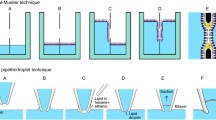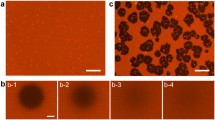Abstract
A new method of membrane reconstitution was developed by fusion of channel protein containing vesicles with planar bilayer membranes. The fusion process only occurred below and near the phase transition temperature of the lipid used. We obtained the following results: 1. Our system is solvent-free and vesicles do not come into contact with the air/water interface. This obviates a possible denaturation of hydrophobic proteins. 2. Channel forming proteins and protein complexes, respectively, are active in a frozen lipid matrix. 3. We detected an unknown channel in cilia fragments. 4. Purified acetylcholine receptors form fluctuating channels in a membrane consisting of a pure synthetic lecithin (two component system).
Similar content being viewed by others
References
Bienvenüe A, Rousselet A, Kato G, Devaux PF (1977) Fluidity of the lipids next to the acetylcholine receptor protein of Torpedo membrane fragments. Use of amphiphilic reversible spin labels. Biochemistry 16:841–848
Boheim G (1974) Statistical analysis of alamethicin channels in black lipid membranes. J Membrane Biol 19:277–303
Boheim G, Hanke W, Eibl H (1980) Lipid phase transition in planar bilayer membrane and its effect on carrier- and pore-mediated ion transport. Proc Natl Acad Sci USA 77:3403–3407
Chapman D, Cornell BA, Eliasz AW, Perry A (1977) Interactions of helical polypeptide segments which span the hydrocarbon region of lipid bilayers. Studies of the gramicidin A lipid-water system. J Mol Biol 113:517–538
Cohen FS, Zimmerberg J, Finkelstein A (1980) Fusion of phospholipid vesicles with planar phospholipid bilayer membranes. II. Incorporation of a vesicular membrane marker into the planar membrane. J Gen Physiol 75:251–270
Eibl H (1980) An efficient synthesis of mixed acid phospholipids using 1-palmitoyl-sn-glycerol-3-phosphoric acid bromoalkyl esters. Chem Phys Lipids 26:239–247
Lawaczeck R, Kainosho M, Girardet J-L, Chan SI (1975) Effects of structural defects in sonicated phospholipid vesicles on fusion and ion permeability. Nature 256:584–586
Machemer H, Ogura A (1979) Ionic conductances of membranes in ciliated and deciliated Paramecium. J Physiol 296:49–60
Marsh D, Barrantes FJ (1978) Immobilized lipid in acetylcholine receptor-rich membranes from Torpedo marmorata. Proc Natl Acad Sci USA 75:4329–4333
Miller C (1978) Voltage-gated cation conductance channel from fragmented sarcoplasmic reticulum: steady state electrical properties. J Membrane Biol 40:1–23
Montal M, Mueller P (1972) Formation of bimolecular membranes from lipid monolayers and a study of their electrical properties. Proc Natl Acad Sci USA 69:3561–3566
Mueller P, Rudin DO, Tien HT, Wescott WC (1963) Methods for the formation of single bimolecular lipid membranes in aqueous solution. J Phys Chem 67:534–535
Neher E, Sakmann B (1976) Single-channel currents recorded from membrane of denervated frog muscle fibres. Nature 260:799–802
Nelson N, Anholt R, Lindstrom J, Montal M (1980) Reconstitution of purified acetylcholine receptors with functional ion channels in planar lipid bilayers. Proc Natl Acad Sci USA 77:3057–3061
Papahadjopoulos D, Vail WJ, Pangborn WA, Poste G (1976a) Studies on membrane fusion. II. Induction of fusion in pure phospholipid membranes by calcium ions and other divalent metals. Biochim Biophys Acta 448:265–283
Papahadjopoulos D, Hui S, Vail WJ, Poste G (1976b) Studies on membrane fusion. I. Interaction of pure phospholipid membranes and the effect of myristic acid, lysolecithin, proteins and dimethylsulfoxide. Biochim Biophys Acta 448:245–264
Papahadjopoulos D, Vail WJ, Newton C, Nir S, Jacobson K, Poste G, Lazo R (1977) Studies on membrane fusion. III. The role of calcium-induced phase changes. Biochim Biophys Acta 465:579–598
Rüchel R, Watters D, Maelicke A (1981) Molecular forms and size of the solubilized acetylcholine receptors from Electrophorus and Torpedo. Submitted for publication
Schindler H, Quast U (1980) Functional acetylcholine receptor from Torpedo marmorata in planar membranes. Proc Natl Acad Sci USA 77:3052–3056
TrÄuble H, Eibl H (1974) Electrostatic effects on lipid phase transitions: membrane structure and ionic environment. Proc Natl Acad Sci USA 71:214–219
Author information
Authors and Affiliations
Rights and permissions
About this article
Cite this article
Hanke, W., Eibl, H. & Boheim, G. A new method for membrane reconstitution: Fusion of protein-containing vesicles with planar bilayer membranes below lipid phase transition temperature. Biophys. Struct. Mechanism 7, 131–137 (1981). https://doi.org/10.1007/BF00539175
Received:
Accepted:
Issue Date:
DOI: https://doi.org/10.1007/BF00539175




